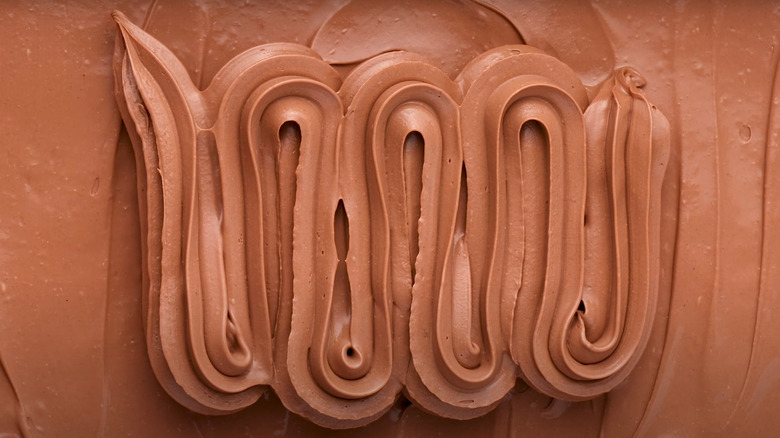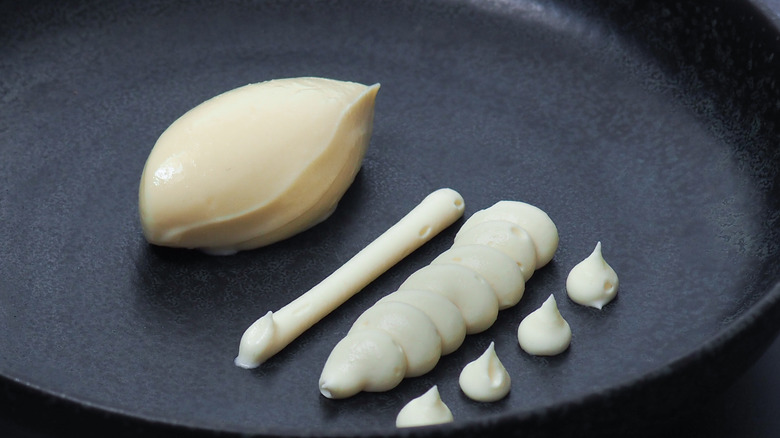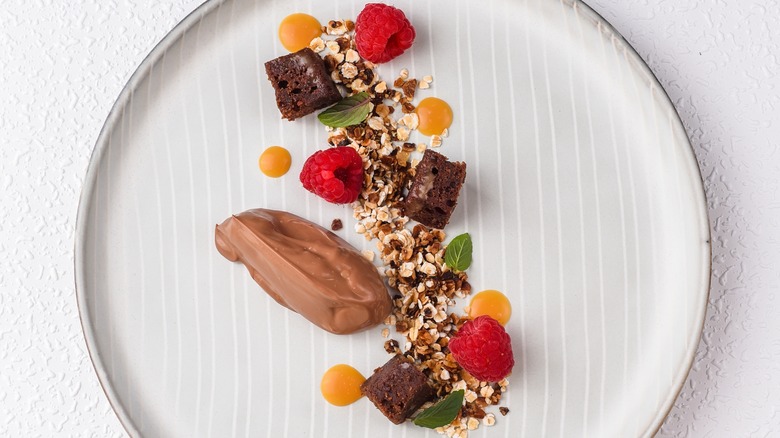What Is Namelaka And What Makes It Different From Ganache?
If your favorite part of a chocolate truffle is its soft center, or you find yourself most excited about the chocolate buttercream sandwiched between layers of cake, it's time you tried the cloud-like, profoundly chocolatey pastry cream known as namelaka. In a single spoonful, you'll discover that it's no wonder the English translation of this Japanese word is "creamy" — the texture of namelaka is smooth as silk. Its origins, however, are rooted in French culinary traditions.
Namelaka was invented at L'École Valrhona, which was first established in 1989 in Paris and now has locations around the world, including Tokyo, Japan. Legend has it that ganache was first created in the City of Light, and it's easy to draw a connection between this dessert and its modern, multicultural cousin, namelaka. Like a sturdier version of ganache, this decadent delicacy is made with just a few simple, yet highly flavorful ingredients. Both offer a rich taste of cocoa that pairs perfectly with a broad array of desserts. There is, however, a subtle, yet noticeable difference in consistency between the two sweet spreads. When compared to ganache, namelaka is more airy and light, like mousse or whipped cream — but also is better able to hold its shape.
Opting for namelaka versus ganache
The four-ingredient batter for both namelaka and traditional chocolate ganache calls for a base of chocolate and cream, but then the two recipes diverge. While ganache incorporates butter and sugar for a luxurious extra dose of dairy and sweetness, namelaka is finished with milk and gelatin, giving it a lighter taste and texture. For a vegetarian alternative, gelatin can be swapped out and agar agar (a plant-based, gelatinous substance) can be easily used instead.
Since namelaka has no additional sugar — unlike ganache — the type of chocolate that you choose will determine the overall final balance of bitter and sweet. The original Valrhona recipe is characterized by the intense, slightly bitter cocoa notes of dark chocolate. If you're aiming for something closer to the mild, creamy character of ganache, you can instead opt for milk chocolate. For an even more delicate and buttery flavor, try using white chocolate as the base.
In some ways, namelaka is even more versatile than ganache, as the recipe itself lends well to creativity. If you start the process of making it a day or two in advance, you can infuse additional flavors into the milk to add complexity. For a quick source of inspiration, think of your favorite breakfast beverage, then experiment with adding instant coffee granules, ground spices (such as cinnamon and nutmeg), black tea, or matcha.
Ways to enjoy namelaka
As with ganache, namelaka can be used as a topping or filling for all kinds of sweet treats, from laminated pastries and custardy pies to cookie sandwiches and brownies. For a special occasion, you can pipe it into chocolate hazelnut profiteroles or slather it across every surface of the ultimate chocolate cake. Its deeply cocoa-forward flavor pairs beautifully with other tropical ingredients, like vanilla, passionfruit, and coconut. Namelaka also makes a great companion for fresh fruits or nutty, earthy elements like toasted pistachios and peanuts, which can also add crunchiness to the dessert for an interesting textural contrast.
For as impressive as namelaka looks and tastes, it's surprisingly simple to make. It only takes a few minutes to whip the ingredients together, but the key is to do so well in advance of whenever you plan to serve dessert. To achieve the ideal consistency, allow the namelaka to firm up in the fridge overnight.
Thanks to the stabilizing qualities of gelatin, namelaka also has a more defined structure than ganache. For this reason, it is more resilient to the melting effect of warm environments and is better suited for layering into elaborate desserts, like entremets, or even to be scooped directly onto a plate in the elegant shell-like shape of a quenelle.



